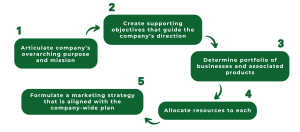Katie Gilstrap, M.B.A.

-Katie Gilstrap, Chapter 5 Author

INTRODUCTION
Digital marketing is a fast-growing technology-driven collection of platforms, tools, skills, and content allowing companies to engage with previous, current, and prospective customers. Note the buyer behavior funnel (awareness, interest, consideration, intent, evaluation, and purchase) is still there, but the friction between stages is greatly reduced and the time interval may be almost instantaneous.
DEFINING MARKETING’S ROLE IN STRATEGIC PLANNING
An organization’s marketing activities could be compared to a concert orchestra. There are different subsections (woodwinds, brass, string, and percussion) that all play different parts, but ultimately work towards delivering the same result (playing the piece of music how it ought to be). In our analogy, the conductor of the orchestra would represent strategic planning. This role is all about looking at the big picture, keeping everyone in sync, and directing the various different players in the collective toward the outcome everyone is striving for.
When there’s a good conductor, the orchestra operates like a well-oiled machine and produces music greater than any of the sections could do if they were simply playing on their own. In the same way, strategic planning ensures that a company’s marketing efforts all work together to deliver the desired results.

Strategic planning lays the groundwork for all subsequent planning initiatives in an organization. The company initiates the strategic planning process at the corporate level by articulating its overarching purpose and mission. This is translated into comprehensive supporting objectives that guide the company’s direction. Following this, the company determines its portfolio of businesses and associated products, as well as the allocation of resources to each. Then each business line formulates a detailed marketing strategy that is aligned with the company-wide plan. Therefore, marketing planning operates across business lines, products, and markets, supporting company strategic planning with more detailed plans developed for specific marketing opportunities.
Strategic Planning Process

MARKET-ORIENTED MISSION
Developing a solid mission answers the questions: What is our reason for being? What value do we create for customers? It is important that the mission statement is market oriented—meaning that rather than describing the company in product or technical terms, it is defined in terms of how the company creates value for the customer. This is because products and technologies eventually become outdated, but the market need and value created endure. Google has developed a strong market-oriented mission. Rather than talking about being a search engine, web browser, mail system, or mapping service, the company defines its mission as “To organize the world’s information and make it universally accessible.”


It is important to remember that a company’s mission statement should also not be stated as “to earn more sales or profits.” Financial rewards only come as a result of creating value for customers. The mission should instead focus on customers and the customer value the company strives to create.
SETTING GOALS AND OBJECTIVES
The company must translate its market-oriented mission into actionable supporting objectives. Each manager should have objectives and be held accountable for achieving them. Marketing strategies and initiatives must be developed to support these objectives. For instance, Yeti’s mission statement is “To ensure that each Yeti product delivers exceptional performance and durability in any environment.” This mission could generate objectives to diversify its product lines, enhance product availability and promotional activities in existing markets, and venture into new markets.  Then, each of these broad marketing objectives need strategies and implementation plans which would be defined in greater, actionable detail. For instance, expanding Yeti’s promotional efforts may require increased advertising and public relations activities—which would need to be precisely defined and outlined. This process illustrates how Yeti’s mission is transformed into a cohesive set of marketing objectives.
Then, each of these broad marketing objectives need strategies and implementation plans which would be defined in greater, actionable detail. For instance, expanding Yeti’s promotional efforts may require increased advertising and public relations activities—which would need to be precisely defined and outlined. This process illustrates how Yeti’s mission is transformed into a cohesive set of marketing objectives.
DESIGNING A BUSINESS PORTFOLIO
Led by the company’s mission statement and objectives, management now must design its business portfolio, which is the combination of the business lines and product offerings. As an example, Yeti’s business portfolio includes coolers, drinkware, bags, and outdoor accessories.
Business portfolio planning involves two steps: first, analyzing the current business portfolio and determining the appropriate level of investment for each business line, and second, developing the future portfolio by developing strategies for either growth or downsizing.
ANALYZING THE CURRENT BUSINESS PORTFOLIOS
The primary focus of strategic planning lies in the analysis of the business portfolio. This involves the management of a company assessing the its products and business lines, with the aim of allocating resources to the most profitable ventures while phasing out or discontinuing weaker ones.
Initially, management identifies the key businesses, known as strategic business units (SBUs), which may include individual business lines, product lines, or brands. Subsequently, the company evaluates the attractiveness of each SBU and determines the appropriate level of investment for each.
The objective of strategic planning is to leverage the company’s strengths to capitalize on market opportunities effectively. Consequently, many portfolio analysis methods evaluate SBUs based on two specific dimensions: first, the attractiveness of the SBU’s market or industry, and second, the SBU’s market position strength. One of the most recognized portfolio-planning methods was developed by the Boston Consulting Group.
INTRODUCTION TO THE BOSTON CONSULTING GROUP GROWTH-SHARE MATRIX
The BCG Growth-Share Matrix categorizes a company’s products or business units into four quadrants based on two key dimensions: market growth rate and relative market share. Market growth rate refers to the rate at which the overall market for a product or service is expanding, while relative market share measures a company’s market share compared to its competitors.
Let’s take a look at the four quadrants of the BCG Growth-Share Matrix:
- Stars: Products or business units with high market share in high-growth markets are classified as stars. These are considered to be the growth engines of a company. Stars typically require significant investment to maintain their growth trajectory and solidify their market position.
- Question Marks: Question Marks are products or business units with low market share in markets experiencing rapid growth. While they operate in attractive markets, they face fierce competition and struggle to gain significant market share. Question marks require careful consideration and investment to determine whether they have the potential to become stars or should be divested.
- Cash Cows: Cash Cows are products or business units with high market share in markets that are stable or that are experiencing limited growth. These established offerings generate substantial cash flow for the company but have limited growth potential. Cash Cows are typically mature and require minimal investment to maintain their market position, allowing the company to harvest profits.
- Dogs: Dogs represent products or business units with low market share in low-growth markets. These offerings have limited growth prospects and typically generate little or no profit. Dogs may drain resources from more promising ventures and may need to be divested or phased out.
BCG Growth-Share Matrix

The BCG Growth-Share Matrix provides valuable insights for strategic decision-making by helping companies allocate resources effectively across their portfolio. It guides managers in determining where to invest, divest, or maintain their efforts based on the growth potential and market position of each product or business unit.
DEVELOPING STRATEGIES FOR GROWTH AND CONTRACTION
In addition to assessing existing businesses, crafting the business portfolio involves identifying potential businesses and products that the company should explore in the future. Growth is imperative for companies seeking enhanced competitiveness, stakeholder satisfaction, and the attraction of top talent. However, it is essential for firms to avoid making growth itself an objective. Instead, the primary objective should be to achieve profitable growth.
One useful tool for identifying growth opportunities is the product/market expansion grid, also known as the Ansoff Matrix. Developed by Igor Ansoff in the 1950s, this matrix provides a framework for analyzing options for growth by considering both existing and new products and markets.
- Market Penetration: Market penetration involves increasing market share for existing products in existing markets. This strategy often involves aggressive marketing campaigns, product improvements, and pricing strategies. Market penetration is particularly beneficial when there is untapped potential within the current market segment or when competitors can be outperformed.
- Product Development: Product development focuses on introducing new products to existing markets. This strategy leverages existing customer bases and distribution channels to introduce innovations, extensions, or improvements to current product lines. Product development is driven by consumer demand for enhanced features, functionalities, or customization options, aiming to capture additional market share and strengthen customer loyalty.
- Market Development: Market development involves entering new markets with existing products. This strategy involves expanding into new geographic regions or demographic segments. Market development requires market research, adaptation of marketing strategies to local preferences, and it also may involve partnerships or alliances to facilitate market entry and establish brand presence in new areas.
- Diversification: Diversification is the most ambitious growth strategy, involving the introduction of new products to new markets. This strategy carries higher risks due to the unfamiliarity of both the product and the market. Diversification can be either related, where the new product or market has some connection to the existing business, or unrelated, where it represents a significant departure from the core business. Successful diversification requires thorough market analysis, strategic planning, and risk management to ensure alignment with organizational capabilities and objectives.
Ansoff Matrix

The product/market expansion matrix serves as a strategic roadmap for businesses to evaluate growth opportunities and prioritize resource allocation. By assessing the potential risks and rewards associated with each growth strategy, companies can make informed decisions to capitalize on market opportunities, expand their customer base, and enhance their competitive position.
MARKETING STRATEGY AND THE MARKETING MIX
Now that we have provided context in terms of organizational strategy, let’s examine customer-driven marketing strategies and programs. The strategic plan outlines the company’s overall mission and objectives. Marketing’s contribution to that is to help answer two key questions: first, which customers will we serve (segmentation and targeting), and second, how will we create value for them (differentiation and positioning)? From there, a marketing strategy that delivers the intended value to the targeted customers will be developed.
Segmenting
The market is filled with different types of customers, products, and needs. Marketers must determine which segments offer the most promise. Consumers can be grouped based on geographic, demographic, psychographic, and behavioral characteristics. Segmentation is the process of dividing the market into distinct groups of buyers with different needs or characteristics and who might therefore need different products or respond differently to various marketing methods.
There are segments in every market, but not all ways of categorizing them are equally helpful. For example, Crest toothpaste wouldn’t gain much by separating users into high-income and low-income groups if both groups respond the same way to marketing efforts.
A market segment includes customers who respond similarly to particular marketing strategies. Take the hotel industry, for example. One segment prefers spacious and luxurious rooms, regardless of price, while another prioritizes affordability. Designing a hotel room that would be the top choices for both segments would be difficult. Therefore, companies are wise to focus on meeting the distinct needs of individual market segments.
Targeting
Once a company has identified its market segments, it can decide to enter one or more of them. Targeting involves assessing the appeal of each segment and choosing the most promising ones to pursue. Companies should aim for segments that can consistently deliver substantial customer value and maintain profitability over time. You will learn more about targeting strategies in Chapter 7 – Segmentation, Targeting, and Positioning.
Differentiation and Positioning
After a company determines which market segments to pursue, it must determine how to differentiate its market offering for each targeted segment and what positions it wants to take in those segments. A product’s position is the place it occupies in the targeted consumers’ minds, relative to the competition. Marketers strive to create unique market positions for their products because if their product is perceived to be the same as others on the market, consumers would have no reason to buy it.
When positioning its brand, a company begins by identifying potential customer value distinctions that can serve as competitive advantages to establish its position. A company can enhance customer value by either offering lower prices compared to competitors or providing additional benefits to justify higher prices. However, if the company promises greater value, it must deliver on that promise. Therefore, effective positioning starts with differentiation—actually setting the company’s market offering apart to provide consumers with more value. Once the company has selected its desired position, it must take decisive actions to deliver and communicate that position to target consumers. The company’s entire marketing program should align with the chosen positioning strategy.
DEVELOPING AN INTEGRATED MARKETING MIX WITH THE 4 P’s
Once the company has defined its overall marketing strategy, it moves on to planning the specifics of the marketing mix, that is, the 4Ps. The marketing mix encompasses a set of tactical tools that the firm combines to achieve its desired response from the target market.
- Product refers to the combination of goods, services, and ideas that the company provides to the target market. Therefore, a Ford Bronco consists of an engine, a muffler, screws, and many other parts. Ford offers several Bronco models and a wide variety of optional features. The vehicle also comes with a warranty that is as much a part of the overall product offering as is the windshield.
- Price represents the amount (e.g., money) given up in the exchange to receive the product offering. For example, Ford sets suggested retail prices for its Bronco models, but dealers often negotiate with customers, offering discounts, trade-in allowances, and credit terms. These adjustments reflect current competition and economic conditions, aligning prices with the buyer’s perception of the vehicle’s value.
- Place refers to the company’s activities that ensure the product is available to target consumers. For example, Ford partners with a network of independently owned dealerships to sell its various models. Ford selects its dealerships carefully and provides strong support. These dealerships keep an inventory of Ford vehicles, demonstrate them to potential buyers, negotiate prices, complete sales, and provide post-sale service for the cars.
- Promotion involves the activities that highlight the product’s benefits and encourage target customers to make a purchase. Ford invests approximately $1.5 billion in U.S. advertising to inform consumers about its brand and products. Salespeople at Ford dealerships assist potential buyers and persuade them that Ford vehicles are the best choice. Ford and its dealerships offer special promotions like sales, cash rebates, and low financing rates to entice purchases. Additionally, Ford actively engages consumers through social media platforms to foster brand connection and interaction with fellow Ford enthusiasts.
A successful marketing program integrates the elements of the marketing mix to create a cohesive strategy aimed at achieving the company’s objectives by delivering value to its key consumers. The marketing mix serves as the company’s tactical toolkit for establishing meaningful positions within target markets.
MANAGING THE MARKETING EFFORT
In addition to excelling in marketing, companies must also focus on effective overall management of the marketing function. Managing the marketing process involves performing four key functions: analysis, planning, implementation, and control. Initially, the company develops company-wide strategic plans and then translates them into marketing plans and other plans for each division, product, and brand. During implementation, the company puts plans into action, while control involves measuring and evaluating the outcomes of marketing activities and making necessary adjustments. Finally, marketing analysis provides essential information and assessments for all other marketing activities.
MARKETING ANALYSIS
Managing the marketing function starts with a thorough analysis of the company’s situation. Marketers should conduct a SWOT analysis, evaluating the company’s strengths (S), weaknesses (W), opportunities (O), and threats (T). Strengths are internal capabilities and resources that enable the company to serve its customers and achieve its objectives. Weaknesses are internal limitations that may hinder the company’s performance. Opportunities refer to favorable external factors or trends in the external environment. Threats encompass unfavorable external factors or trends that may pose challenges. Let’s imagine we’re doing a SWOT analysis for a small business, “Backcountry Toes,” that makes merino wool hiking socks. Strengths for BT are that they have access to the highest quality wool and they offer socks with a variety of different colors and designs. A weakness is that they haven’t been able to get products into R.E.I. yet, and are overly reliant on sales through their own webstore. An opportunity for BT is expanding their business into other merino wool products like beanies and scarves, due to the growing popularity of the material among consumers. Last, a threat is a trend among their competitors to move their production overseas, allowing them to offer lower retail prices and threaten BT’s position as a “value” option for hiking socks.
SWOT Analysis for Backcountry Toes

MARKETING PLANNING
Through strategic planning, the company determines its objectives for each business unit. Marketing planning involves selecting strategies that align with the company’s overarching strategic goals. A comprehensive marketing plan is essential for each business, product, or brand within the organization.
The plan begins with an executive summary, offering a concise overview of key insights, goals, and recommendations. The primary section of the plan provides an in-depth SWOT analysis of the current marketing situation, highlighting assessments developed from evaluating the four SWOT elements. Subsequently, the plan articulates objectives for the brand and outlines a marketing strategy designed to accomplish them.
A marketing strategy includes specific plans for target markets, positioning, the marketing mix, and budgeting. It explains how the company aims to create value for customers and capture value in return. In this section, the planner describes how each strategy addresses earlier identified threats, opportunities, and critical issues. Additional sections outline an action plan for implementing the marketing strategy and detail the supporting budget. The final section describes the controls to monitor progress, measure return on investment, and make adjustments.
MARKETING IMPLEMENTATION
Creating effective strategies is just the beginning of successful planning. Even the most brilliant marketing strategy is of little value if the company doesn’t implement it properly. Marketing implementation is the process that translates marketing plans into actions to achieve strategic marketing objectives. While marketing planning focuses on the what and why of marketing activities, implementation tackles the who, where, when, and how.
MARKETING CONTROL
Marketing control is essential for overseeing and optimizing marketing activities within a company. It involves systematically assessing marketing strategies and plans to ensure they meet overall business goals. Through marketing control, organizations monitor the performance of their marketing efforts, detect deviations from expected outcomes, and take corrective measures as necessary. This process enables companies to adapt to market changes, seize opportunities, and address challenges effectively. By implementing marketing control mechanisms, businesses can enhance accountability, improve marketing performance, and ultimately achieve sustainable growth and competitive advantage.
SUMMARY
We began the chapter by discussing how strategic planning acts as a foundation for future planning activities in an organization. Relatedly, the concept of developing a market-oriented mission answers fundamental questions for businesses. A company must translate its mission, however, into concrete, actionable objectives. Together, a company’s mission and objectives are what guide decisions about the business portfolio. Further, the BCG Growth Matrix is a source of strategic insights, and the Ansoff Matrix helps identify growth opportunities. Segmentation is the process of dividing consumers into groups based upon characteristics, and targeting is how a company identifies the segment they want to reach. Then, they must decide how to differentiate their product for each targeted segment and what positions they want to take in those segments. After a company has developed a marketing strategy, the 4Ps of the marketing mix (product, place, price, promotion) must be decided upon. Last, managing the marketing process consists of four functions: analysis, which involves doing a SWOT analysis; planning, or selecting strategies that align with the company’s overarching strategic goals; implementation, the process that translates marketing plans into actions to achieve strategic marketing objectives; and control, which is assessing marketing strategies to ensure they meet business goals.
REFERENCES
Kotler, P., & Armstrong, G. Principles of Marketing (18th ed.). Pearson Education. 2022.
Aaker, D. A. Strategic Market Management (11th ed.). John Wiley & Sons. 2020.
Drucker, P. F. The Practice of Management. Harper & Row. 1954.
Kotler, P., & Keller, K. L. Marketing Management (15th ed.). Pearson Education. 2016.
Ansoff, I. H. Corporate Strategy: An Analytic Approach to Business Policy for Growth and Expansion. McGraw-Hill. 1965.
West, D. C., Ford, J., & Ibrahim, E. Strategic Marketing: Creating Competitive Advantage (3rd ed.). Oxford University Press. 2015.
Kaplan, R. S., & Norton, D. P. The Balanced Scorecard: Translating Strategy into Action. Harvard Business School Press. 1996.
Piercy, N. F. Customer-Driven Marketing Strategy: Segmentation, Targeting, and Positioning. Wiley. 2014.
Walker, O. C., & Mullins, J. W. Marketing Strategy: A Decision-Focused Approach (8th ed.). McGraw-Hill Education. 2014.
Ansoff, H. I. Strategic Management. Palgrave Macmillan. 1984.
Media Attributions
- Header by Z. Farley
- Conductor by Karaoglanoglu via Pexels
- Diagram by Z. Farley
- Diagram by Z. Farley
- Diagram by Z. Farley
- YETI Mug by Ajay Suresh, licensed under the Creative Commons Attribution 2.0 Generic
- Diagram by Z. Farley
- Coca Cola Santa Christmas Display by Mike Mozart, licensed under CC BY 2.0. Coca Cola Vanilla by Creative Tools, licensed under CC BY 2.0. Coke Zero by Rohit Sharma, licensed under Pexels. Coke Shirt by Printerval, licensed under CC BY 2.0.
- Diagram by Z. Farley
The combination of a company’s business lines and product offerings
Key businesses, which may include individual business lines, product lines, or brands
Categorizes a company's products or business units into four quadrants based on two key dimensions: market growth rate and relative market share
Refers to the rate at which the overall market for a product or service is expanding
Measures a company's market share compared to its competitors
One of the four quadrants of the BCG Growth Share Matrix. Products or business units with high market share in high-growth markets
One of the four quadrants of the BCG Growth Share Matrix. Products or business units with low market share in markets experiencing rapid growth
One of the four quadrants of the BCG Growth Share Matrix. Products or business units with high market share in markets that are stable or that are experiencing limited growth
One of the four quadrants of the BCG Growth Share Matrix. Products or business units with low market share in low-growth markets
Provides a framework for analyzing options for growth by considering both existing and new products and markets
One of the four quadrants of the Ansoff Matrix. Involves increasing market share for existing products in existing markets
One of the four quadrants of the Ansoff Matrix. Focuses on introducing new products to existing markets
One of the four quadrants of the Ansoff Matrix. Involves entering new markets with existing products
One of the four quadrants of the Ansoff Matrix. Is the most ambitious growth strategy, involving the introduction of new products to new markets
The process of dividing the market into distinct groups of buyers with different needs or characteristics and who might therefore need different products or respond differently to various marketing methods
Involves assessing the appeal of each segment and choosing the most promising ones to pursue
The place a product occupies in the targeted consumers’ minds, relative to the competition
Setting the company's market offering apart to provide consumers with more value
Evaluating the company's strengths (S), weaknesses (W), opportunities (O), and threats (T)
One of the four components of SWOT analysis. Internal capabilities and resources that enable the company to serve its customers and achieve its objectives
One of the four components of SWOT analysis. Internal limitations that may hinder the company's performance
One of the four components of SWOT analysis. Refer to favorable external factors or trends in the external environment
One of the four components of SWOT analysis. Encompass unfavorable external factors or trends that may pose challenges
Involves selecting strategies that align with the company's overarching strategic goals
Includes specific plans for target markets, positioning, the marketing mix, and budgeting
The process that translates marketing plans into actions to achieve strategic marketing objectives
Involves systematically assessing marketing strategies and plans to ensure they meet overall business goals
